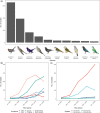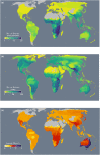The overlooked complexity of avian brood parasite-host relationships
- PMID: 35763605
- PMCID: PMC9543277
- DOI: 10.1111/ele.14062
The overlooked complexity of avian brood parasite-host relationships
Abstract
The relationships between avian brood parasites and their hosts are widely recognised as model systems for studying coevolution. However, while most brood parasites are known to parasitise multiple species of host and hosts are often subject to parasitism by multiple brood parasite species, the examination of multispecies interactions remains rare. Here, we compile data on all known brood parasite-host relationships and find that complex brood parasite-host systems, where multiple species of brood parasites and hosts coexist and interact, are globally commonplace. By examining patterns of past research, we outline the disparity between patterns of network complexity and past research emphases and discuss factors that may be associated with these patterns. Drawing on insights gained from other systems that have embraced a multispecies framework, we highlight the potential benefits of considering brood parasite-host interactions as ecological networks and brood parasitism as a model system for studying multispecies interactions. Overall, our results provide new insights into the diversity of these relationships, highlight the stark mismatch between past research efforts and global patterns of network complexity, and draw attention to the opportunities that more complex arrangements offer for examining how species interactions shape global patterns of biodiversity.
Keywords: bird; brood parasitism; coevolution; cowbird; cuckoo; ecology; evolution; multispecies interactions.
© 2022 The Authors. Ecology Letters published by John Wiley & Sons Ltd.
Figures





Similar articles
-
Long-term coevolution between avian brood parasites and their hosts.Biol Rev Camb Philos Soc. 2014 Aug;89(3):688-704. doi: 10.1111/brv.12075. Epub 2013 Dec 14. Biol Rev Camb Philos Soc. 2014. PMID: 24330159
-
The evolution of acceptance and tolerance in hosts of avian brood parasites.Biol Rev Camb Philos Soc. 2016 Aug;91(3):569-77. doi: 10.1111/brv.12181. Epub 2015 Mar 12. Biol Rev Camb Philos Soc. 2016. PMID: 25765722 Review.
-
Reconciling genetic expectations from host specificity with historical population dynamics in an avian brood parasite, Horsfield's Bronze-Cuckoo Chalcites basalis of Australia.Mol Ecol. 2002 Apr;11(4):829-37. doi: 10.1046/j.1365-294x.2002.01481.x. Mol Ecol. 2002. PMID: 11972768
-
The common redstart as a suitable model to study cuckoo-host coevolution in a unique ecological context.BMC Evol Biol. 2016 Nov 25;16(1):255. doi: 10.1186/s12862-016-0835-5. BMC Evol Biol. 2016. PMID: 27887566 Free PMC article.
-
Colour, vision and coevolution in avian brood parasitism.Philos Trans R Soc Lond B Biol Sci. 2017 Jul 5;372(1724):20160339. doi: 10.1098/rstb.2016.0339. Philos Trans R Soc Lond B Biol Sci. 2017. PMID: 28533456 Free PMC article. Review.
Cited by
-
Lack of response to conspecific juvenile vocalizations in two avian brood parasites.Curr Zool. 2023 Nov 30;70(5):589-595. doi: 10.1093/cz/zoad053. eCollection 2024 Oct. Curr Zool. 2023. PMID: 39463699 Free PMC article.
-
When perfection isn't enough: host egg signatures are an effective defence against high-fidelity African cuckoo mimicry.Proc Biol Sci. 2023 Jul 26;290(2003):20231125. doi: 10.1098/rspb.2023.1125. Epub 2023 Jul 26. Proc Biol Sci. 2023. PMID: 37491965 Free PMC article.
-
Importance of cooperation: How host nest defenses effectively prevent brood parasitism from the cuckoos.iScience. 2023 Mar 21;26(4):106458. doi: 10.1016/j.isci.2023.106458. eCollection 2023 Apr 21. iScience. 2023. PMID: 37063465 Free PMC article.
-
Nest architecture influences host use by avian brood parasites and is shaped by coevolutionary dynamics.Proc Biol Sci. 2024 Jan 10;291(2014):20231734. doi: 10.1098/rspb.2023.1734. Epub 2024 Jan 10. Proc Biol Sci. 2024. PMID: 38196369 Free PMC article.
-
Climate change is associated with asynchrony in arrival between two sympatric cuckoos and both host arrival and prey emergence.R Soc Open Sci. 2024 Jan 17;11(1):231691. doi: 10.1098/rsos.231691. eCollection 2024 Jan. R Soc Open Sci. 2024. PMID: 38234437 Free PMC article.
References
-
- Afkhami, M.E. , Rudgers, J.A. & Stachowicz, J.J. (2014) Multiple mutualist effects: conflict and synergy in multispecies mutualisms. Ecology, 95, 833–844. - PubMed
-
- Atencio, M. , Reboreda, J.C. & Mahler, B. (2020) Brood parasitism leads to zero recruitment in the globally endangered yellow cardinal Gubernatrix cristata . Bird Conservation International, 32, 1–7.
-
- Bascompte, J. , Jordano, P. & Olesen, J.M. (2006) Asymmetric coevolutionary networks facilitate biodiversity maintenance. Science, 312, 431–433. - PubMed
Publication types
MeSH terms
Grants and funding
LinkOut - more resources
Full Text Sources
Other Literature Sources
Miscellaneous

